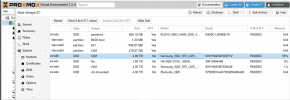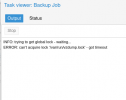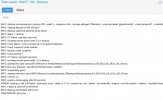I have LVM thin provisioned on a 1 TB WD Blue SSD. In use for about 10 months and has, until recently, always reported 0% Wearout in PVE web UI.
Recently, this has jumped to 98%! The disk is puportedly good for 400TBW and I don't believe I have over taxed it. It's about 25% capacity, I have done a few dozen VM/CT restores from snapshots and backups, but nothing beyond a normal home lab workload IMO. All the VM's have modest disk size/write requirements.
AIUI, disk wearout reported in PVE Web UI is `100 - Media_Wearout_Indicator`. However, since monitoring started (shortly after installation) this value has mostly been 1, rising recently to 2. PVE UI has reported 0% Wearout until very recently. What has increased steadily, albeit with a few jumps, is the raw value of said attribute. I have no idea what the raw value actually represents or how the attribute value (currently 2) relates to it.
So, I'm wondering is the disk really near end of life already and how do we interpret that raw value (0x020b0032020b)?
I'd be grateful for any insight and advice on the state of the SSD!
Many thanks.
smartctl currently reports:
Recently, this has jumped to 98%! The disk is puportedly good for 400TBW and I don't believe I have over taxed it. It's about 25% capacity, I have done a few dozen VM/CT restores from snapshots and backups, but nothing beyond a normal home lab workload IMO. All the VM's have modest disk size/write requirements.
AIUI, disk wearout reported in PVE Web UI is `100 - Media_Wearout_Indicator`. However, since monitoring started (shortly after installation) this value has mostly been 1, rising recently to 2. PVE UI has reported 0% Wearout until very recently. What has increased steadily, albeit with a few jumps, is the raw value of said attribute. I have no idea what the raw value actually represents or how the attribute value (currently 2) relates to it.
So, I'm wondering is the disk really near end of life already and how do we interpret that raw value (0x020b0032020b)?
I'd be grateful for any insight and advice on the state of the SSD!
Many thanks.
smartctl currently reports:
Code:
smartctl 7.1 2019-12-30 r5022 [x86_64-linux-5.4.73-1-pve] (local build)
Copyright (C) 2002-19, Bruce Allen, Christian Franke, www.smartmontools.org
=== START OF INFORMATION SECTION ===
Model Family: WD Blue and Green SSDs
Device Model: WDC WDS100T2B0A-00SM50
Serial Number: 194526801184
LU WWN Device Id: 5 001b44 8b1149bcb
Firmware Version: 411030WD
User Capacity: 1,000,204,886,016 bytes [1.00 TB]
Sector Size: 512 bytes logical/physical
Rotation Rate: Solid State Device
Form Factor: 2.5 inches
Device is: In smartctl database [for details use: -P show]
ATA Version is: ACS-4 T13/BSR INCITS 529 revision 5
SATA Version is: SATA 3.3, 6.0 Gb/s (current: 6.0 Gb/s)
Local Time is: Sun Nov 29 14:17:08 2020 GMT
SMART support is: Available - device has SMART capability.
SMART support is: Enabled
=== START OF READ SMART DATA SECTION ===
SMART overall-health self-assessment test result: PASSED
General SMART Values:
Offline data collection status: (0x00) Offline data collection activity
was never started.
Auto Offline Data Collection: Disabled.
Self-test execution status: ( 0) The previous self-test routine completed
without error or no self-test has ever
been run.
Total time to complete Offline
data collection: ( 0) seconds.
Offline data collection
capabilities: (0x11) SMART execute Offline immediate.
No Auto Offline data collection support.
Suspend Offline collection upon new
command.
No Offline surface scan supported.
Self-test supported.
No Conveyance Self-test supported.
No Selective Self-test supported.
SMART capabilities: (0x0003) Saves SMART data before entering
power-saving mode.
Supports SMART auto save timer.
Error logging capability: (0x01) Error logging supported.
General Purpose Logging supported.
Short self-test routine
recommended polling time: ( 2) minutes.
Extended self-test routine
recommended polling time: ( 10) minutes.
SMART Attributes Data Structure revision number: 4
Vendor Specific SMART Attributes with Thresholds:
ID# ATTRIBUTE_NAME FLAG VALUE WORST THRESH TYPE UPDATED WHEN_FAILED RAW_VALUE
5 Reallocated_Sector_Ct 0x0032 100 100 --- Old_age Always - 0
9 Power_On_Hours 0x0032 100 100 --- Old_age Always - 7526
12 Power_Cycle_Count 0x0032 100 100 --- Old_age Always - 124
165 Block_Erase_Count 0x0032 100 100 --- Old_age Always - 102106146
166 Minimum_PE_Cycles_TLC 0x0032 100 100 --- Old_age Always - 1
167 Max_Bad_Blocks_per_Die 0x0032 100 100 --- Old_age Always - 72
168 Maximum_PE_Cycles_TLC 0x0032 100 100 --- Old_age Always - 14
169 Total_Bad_Blocks 0x0032 100 100 --- Old_age Always - 609
170 Grown_Bad_Blocks 0x0032 100 100 --- Old_age Always - 0
171 Program_Fail_Count 0x0032 100 100 --- Old_age Always - 0
172 Erase_Fail_Count 0x0032 100 100 --- Old_age Always - 0
173 Average_PE_Cycles_TLC 0x0032 100 100 --- Old_age Always - 5
174 Unexpected_Power_Loss 0x0032 100 100 --- Old_age Always - 1
184 End-to-End_Error 0x0032 100 100 --- Old_age Always - 0
187 Reported_Uncorrect 0x0032 100 100 --- Old_age Always - 0
188 Command_Timeout 0x0032 100 100 --- Old_age Always - 0
194 Temperature_Celsius 0x0022 071 040 --- Old_age Always - 29 (Min/Max 14/40)
199 UDMA_CRC_Error_Count 0x0032 100 100 --- Old_age Always - 0
230 Media_Wearout_Indicator 0x0032 002 002 --- Old_age Always - 0x020b0032020b
232 Available_Reservd_Space 0x0033 100 100 004 Pre-fail Always - 100
233 NAND_GB_Written_TLC 0x0032 100 100 --- Old_age Always - 5542
234 NAND_GB_Written_SLC 0x0032 100 100 --- Old_age Always - 16535
241 Host_Writes_GiB 0x0030 253 253 --- Old_age Offline - 13958
242 Host_Reads_GiB 0x0030 253 253 --- Old_age Offline - 8508
244 Temp_Throttle_Status 0x0032 000 100 --- Old_age Always - 0
SMART Error Log Version: 1
No Errors Logged
SMART Self-test log structure revision number 1
Num Test_Description Status Remaining LifeTime(hours) LBA_of_first_error
# 1 Short offline Completed without error 00% 7515 -
# 2 Short offline Completed without error 00% 7491 -
# 3 Short offline Completed without error 00% 7467 -
# 4 Extended offline Completed without error 00% 7445 -
# 5 Short offline Completed without error 00% 7421 -
# 6 Short offline Completed without error 00% 7397 -
# 7 Short offline Completed without error 00% 7373 -
# 8 Short offline Completed without error 00% 7348 -
# 9 Short offline Completed without error 00% 7324 -
#10 Short offline Completed without error 00% 7300 -
#11 Extended offline Completed without error 00% 7276 -
#12 Short offline Completed without error 00% 7252 -
#13 Short offline Completed without error 00% 7228 -
#14 Short offline Completed without error 00% 7204 -
#15 Short offline Completed without error 00% 7180 -
#16 Short offline Completed without error 00% 7156 -
#17 Short offline Completed without error 00% 7132 -
#18 Extended offline Completed without error 00% 7108 -
#19 Short offline Completed without error 00% 7084 -
#20 Short offline Completed without error 00% 7059 -
#21 Short offline Completed without error 00% 7035 -
Selective Self-tests/Logging not supported




